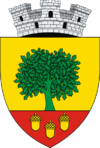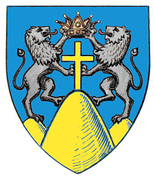Cajvana
| Cajvana | ||
|---|---|---|
| Town | ||
| ||
 Cajvana Location of Cajvana | ||
| Coordinates: 47°42′16″N 25°58′10″E / 47.70444°N 25.96944°ECoordinates: 47°42′16″N 25°58′10″E / 47.70444°N 25.96944°E | ||
| Country |
| |
| County | Suceava County | |
| Status | Town | |
| Government | ||
| • Mayor | Gheorghe Tomăscu (Social-Liberal Union) | |
| Area | ||
| • Total | 24.83 km2 (9.59 sq mi) | |
| Population (2011 census)[1] | ||
| • Total |
| |
| • Density | 274/km2 (710/sq mi) | |
| Time zone | EET (UTC+2) | |
| • Summer (DST) | EEST (UTC+3) | |
| Climate | Dfb | |
| Website | Unofficial site | |
| Historical population | ||
|---|---|---|
| Year | Pop. | ±% |
| 2002 | 7,263 | — |
| 2011 | 6,812 | −6.2% |
| Source: Census data | ||
Cajvana is a town in Suceava County, north-eastern Romania. It is situated in the historical region of Bukovina. Cajvana is the twelfth-largest urban settlement in the county, with a population of 6,812 inhabitants, according to the 2011 census. It was declared a town in 2004, along with seven other localities in Suceava County. One village, Codru, is administered by the town.
Cajvana is located at a distance of 36 kilometres (22 miles) away from Suceava, the county capital. The town is known for its legendary oak tree, which dates from the time of Moldavian ruler Stephen the Great (1457–1504). Despite being a town, Cajvana has a rural aspect and the main occupation of the inhabitants is agriculture. The locality was severely affected by the European floods in 2005.
Notes
- ↑ "Suceava County at the 2011 census" (PDF) (in Romanian). INSSE. February 2, 2012. Retrieved March 12, 2012.
External links
| Wikimedia Commons has media related to Cajvana. |
- (Romanian) Cajvana Town Hall web page
- (Romanian) Cajvana High School
- (Romanian) Suceava County site – Cajvana web page

